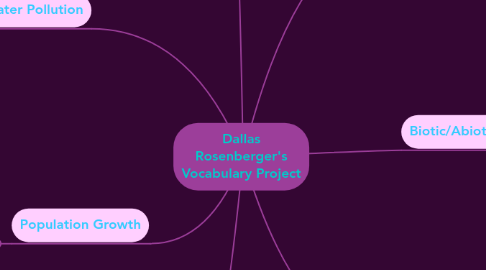
1. Trophic Levels
1.1. Desert
1.1.1. A region so arid because of little rainfall that it supports only sparse and widely spaced vegetation or no vegetation at all.
1.2. Tundra
1.2.1. One of the vast, nearly level, treeless plains of the arctic regions.
1.3. Grassland
1.3.1. An area, as a prarie, in which the natural vegetation consists largely of perennial grasses, characteristic of subhumid and semiarid climates.
1.4. Freshwater Biome
1.4.1. The aquatic biome consisting of water containing fewer salts than the waters in the marine biome.
1.5. Marine Biome
1.5.1. Includes all the water that is on Earth's surface.
2. The Industrial Revolution
2.1. Pioneer Species
2.1.1. The first species of trees to establish in an area after a disturbance, such as fire or logging.
2.2. Climax Community
2.2.1. A biological community of plants and animals which, through the process of ecological succession- the development of vegetation in an area over time- has reached a steady state.
2.3. Limitin Factors
2.3.1. Controls a process, such as organism growth or species, population, size or distribution.
2.4. Carrying Capacity
2.4.1. The number or quantity of people or things that can be conveyed or held by a vehicle or container.
2.5. Population Growth
2.5.1. Increase in the number of people who inhabit a territory or state.
2.6. Black Plague
2.6.1. The epidemic form of bubonic plague experinced during the Middle Ages when it killed nearly half the people of Western Europe.
2.7. Industrial Revolution
2.7.1. The rapid development of industry in Britain in the late 18th and 19th centuries, brought about by the introduction of machinery.
2.8. Exponential Growth
2.8.1. Growth whose rate becomes ever more rapid in proportion to the growing total number or size.
3. Population Growth
3.1. Sustainability
3.1.1. Describes how biological systems remain diverse and productive over time.
3.2. Logistic Growth
3.2.1. Population growth in which the growth rate decreases with increasin number of individuals until it becomes zero when the population reaches a maximum.
3.3. J-Curve
3.3.1. Graph pattern showing the effect of depreciation of a currency on a country's tade deficit.
3.4. S-Curve
3.4.1. One having two arcs with their centers on opposite sides of the curve.
3.5. Population Growth Rate
3.5.1. The change in a population over time.
4. Water Pollution
4.1. Aquifer
4.1.1. A body of permeable rock that can contain or transmit groundwater.
4.2. Water Pollution
4.2.1. Pollution of the water in rivers and lakes.
4.3. Point source
4.3.1. Can be traced back to a single origin or source such as a sewage treatment plant discharge.
4.4. Non-Point Source
4.4.1. Affecting a water body from diffuse sources such as polluted runoff from agricultural area draining into a river, or wind-borne debris blowing out to sea.
5. Levels of Organization
5.1. Organism
5.1.1. Any form of life.
5.2. Community
5.2.1. Populations of living organisms that interact with one another in an ecosystem.
5.3. Ecosytem
5.3.1. Group of living organisms that interact with one another and the nonliving physical environment as one unit.
5.4. Biome
5.4.1. Geographic region of Earth that is inhabited by a community of distinct types of plant and associated animal species.
5.5. Biosphere
5.5.1. Layer of soil, water, and air that sustains life.
5.6. Population-
5.6.1. A particular section, group, or type of people or animals living in an area or country.
6. Biotic/Abiotic Factors
6.1. Biotic Factors
6.1.1. The factors in a biome/ecosystem/habitat that include all living things.
6.2. Abiotic Factors
6.2.1. Non-living chemical and physical factors in the environment.
6.3. Biodiversity
6.3.1. The variety of life in the world or in a particular habitat or ecosystem.
7. Succession
7.1. Hotspots
7.1.1. A small area or region with a relatively hot temperature in comparison to its surroundings.
7.2. Ecological Succession
7.2.1. The gradual process of change in an ecosystem brought about by the progressive replacement of one community by another in a definite order.
7.3. Primary Succession- Is one of two types of biological and ecological succession of plant life, occurring in an environment in which new substrate devoid of vegetation and usually lacking soil, such as a lava flow or area left from retreated glacier.
7.4. Secondary Succession
7.4.1. As opposed to primary successio, secondary succession is a process started by an event that reduces an already established ecosystem.
